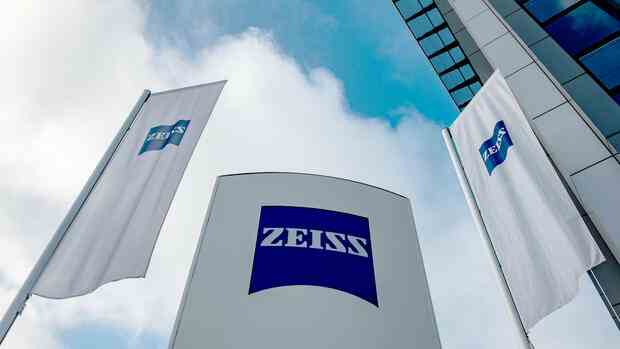In the past year, the turnover of the semiconductor division of Carl Zeiss increased by a fifth to 2.7 billion euros.
(Photo: dpa)
Stuttgart Carl Zeiss rushes from record year to record year. The 176-year-old optics and technology group from Oberkochen is feeling the global supply chain problems. But only a few companies are currently able to cope with the current crises in the world and at the same time expand as strongly as Carl Zeiss.
In the 2021/22 financial year (September 30), the turnover of the foundation company rose by 16 percent to 8.8 billion euros and thus exceeded eight billion euros for the first time. “The success shows that we are on the right track with our strategy, which is geared towards megatrends such as digitization,” said CEO Karl Lamprecht.
The consolidated operating result climbed by 109 million to almost 1.6 billion euros. The return of almost 20 percent is exceptional for an industrial group and thus surpasses the profit king Porsche. In 2021, the sports car manufacturer achieved an operating return on sales of 16 percent.
Chip technology drives the business
Everything looks as if the record drive of the Swabian technology group will continue. Because Lamprecht reports a 19 percent increase in incoming orders to 10.7 billion euros. For this financial year, he expects “further brisk growth” and a return of around 15 percent. The manager did not want to be more precise because of the uncertain global situation and delivery bottlenecks, especially for semiconductors.
Top jobs of the day
Find the best jobs now and
be notified by email.
The biggest growth driver is the semiconductor business: Without Zeiss optics as a key component, the latest generation of chips in devices such as the Apple iPhone or MacBook would not exist. In fact, only Zeiss, with its partners ASML and laser specialist Trumpf, has mastered the so-called EUV technology. With the use of extreme ultraviolet light, the companies have made a real leap in technology in global chip production.
The CEO of Carl Zeiss expects “continued brisk growth”.
(Photo: AP)
In the past year, the turnover of the semiconductor division of Carl Zeiss increased by a fifth to 2.7 billion euros. The company wants to expand its pioneering position: “We always think a decade ahead,” says Lamprecht. In Oberkochen, work is already underway on the next generation, called “High-NA-EUV”, and production facilities are already being built.
>> Also read: USA lures chip giant TSMC into the country – and triggers existential fears in Taiwan
Carl Zeiss puts a lot of effort into future success. The Swabians spend around 13 percent of sales on research and development. This is also a value rarely achieved in the processing industry.
In industrial measurement technology and microscopy, sales rose by 15 percent to two billion euros. Here, Zeiss benefited from the car manufacturers’ switch to alternative drives and from good business with microscopes for research and science.
Carl shows it
20
percent return
makes Carl Zeiss approximately. The value is obtained by comparing the Group’s operating result with sales.
In November, Zeiss won the German Future Prize, presented by the Federal President, for the second time in two years, this time for a microscope with which, for the first time, it is possible to observe the cell division of malaria pathogens, for example, over a longer period of time.
“With our technology, the pharmaceutical industry will be able to develop new drugs much more precisely,” Lamprecht is convinced. The listed medical technology division was able to increase sales by 15 percent to 2.2 billion euros and the spectacles and binoculars sector by 13 percent to 1.5 billion euros. Zeiss is developing into a job engine. The number of employees increased by ten percent to 38,770.
More: Industry is investing more in innovations again – but one industry is lagging behind
